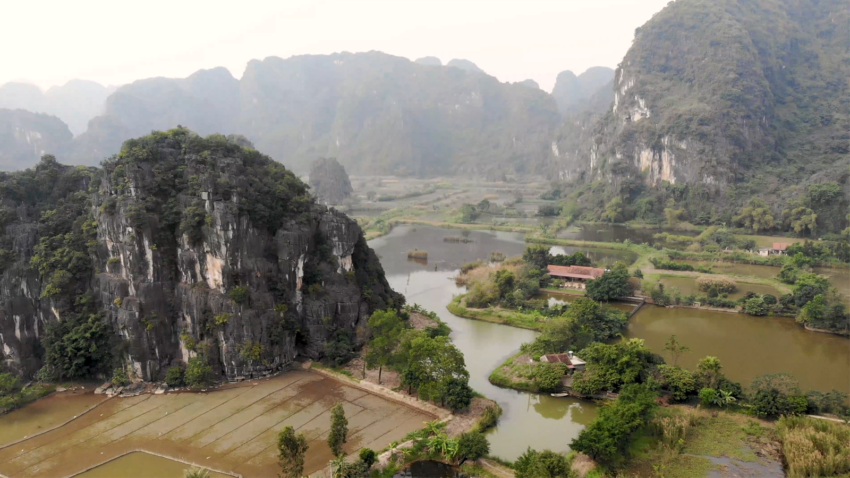Ninh Binh is someplace I’ve wanted to go since the last trip to Vietnam. As is typical, it all started with a picture. Ninh Binh is stunning. It is called the Ha Long Bay on land and that is an accurate description.
Ninh Binh is located south east of Ha Noi (Hanoi) near where the Red River empties into the Gulf of Tonkin. This region is generally a flooded lowland full of rice paddies. What makes Ninh Binh unique is the towering limestone formations that rise vertically from a sea of mud. Most of the year the area is a tapestry of deep green or yellow as the rice goes through its various growth stages. We happened to be there in the rice planting season so it was mostly mud brown. Carving through this amazing landscape are numerous streams and rivers. Milennia ago these waterways carved limestone caves straight through the mountains with the rock dissolving into the water. Today its an aquatic highway for tourists and local rice farmers. The landscape is so exotic that it was the backdrop for “Skull Island” in the recent Kong movie.
Ninh Binh also has historical significance. For 46 years, from approximately 950-1000 AD, the Royal Family located the capital to Ninh Binh hoping to use its geology as defense against the invading Mongul Empire. Legend has it that the Vietnam monarchy placed pilings in the rivers to prevent the Mongul armies, which were traveling by boat, from approaching. However, it was the rainy season and the water was high so their boats floated over the defenses and made it to Ninh Binh. The locals retreated high into the mountains and burned their fields and killed their livestock, hoping to starve the Mongul army. This approach worked, to a degree, and they were able to win several victories against the weakened army. Eventually the Monguls went to return home. By this time the water level had dropped and their ships were blocked from retreat and more victories were scored.
Today Ninh Binh is an agricultural community and home to many limestone quarries, where large industrial equipment are slowly eating mountains of limestone (don’t worry – there are plenty left) and churning out cement – a key building block for the growing Vietnamese economy. The local concrete barrons have some amazing (and obscene) houses.
Ninh Binh also has a fast growing tourist economy. The historical landmarks have been recently refreshed with new structures incorporating ancient relics. There are numerous options for taking a boat tour up these magical waterways and through caves. Each boatperson (there are both men and women) use the local tradition of rowing with your feet. Given that your legs are significantly stronger than you arms, it makes a lot of sense and you have to wonder why this didn’t evolve in other parts of the world.
Getting There / Doing That: We visited Ninh Binh as a long day trip from Ha Noi. We were picked up at 7:50 am and it’s a 2.5 hour drive there with a rest / tourist stop. We did a boat trip and a bike trip with Ecoway Travel (read our Trip Advisor post – link).
Looking back, we wish we would have stayed a day or two in a local town to fully explore the region.


Most post scripts!
Nancy